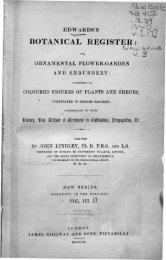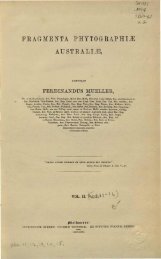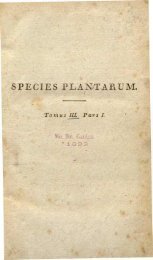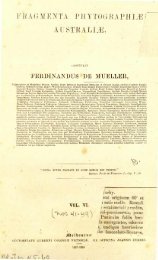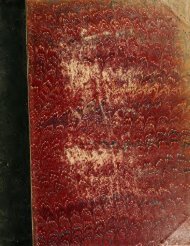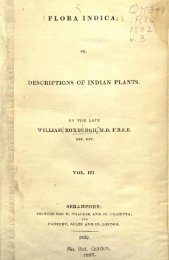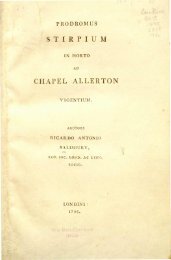Botanical Magazine 106 - 1880.pdf - hibiscus.org
Botanical Magazine 106 - 1880.pdf - hibiscus.org
Botanical Magazine 106 - 1880.pdf - hibiscus.org
You also want an ePaper? Increase the reach of your titles
YUMPU automatically turns print PDFs into web optimized ePapers that Google loves.
TAB. 6509.<br />
EPIMEDIÜM PERIULDERIANCM.<br />
Native of Algeria.<br />
Nat. Oril. BERBERIDE.E.•Tribe BERBèRES.<br />
Genus EPIMEDIüM, Linn.; (Benth. et Hook.f. Gen. Plant, vol. i. p. 44.)<br />
EPIMEDIüM Perralderianum; sparse patentim pilosa, fol i is 3-folioIaKs, foliolis<br />
coriaceis perennantibus cordato-ovatis acutis ciliato-dentatis, sinu elongit><br />
angusto, auriculis rotundatis, pedúnculo radicali petiolo ae^uilongo, raoemo<br />
multifloro glanduloso-piloso, pedieellis gracilibus horizontaliter pitentibus,<br />
floribus aureis, sepalis extimis minutis oblongis obtusis caducis, intimis fere<br />
orbicularibus horizontalibus late irabricatis, pettiorura lamina erecta inirgine<br />
dentata, calcare incurva robusta obtusa laminae aîçruilonga, staminibus petalis<br />
triplo longioribus flavis.<br />
E. Perralderianum, Cosson in Kralik PL Alger. Sel. exsicc. No. 100, et in Bull.<br />
Soc. Bot. France, vol. ix. p. 167 (1867) ; Baker in Gard. Chron. 1880, p. 683.<br />
This is the African representative of the Persian and<br />
Caucasian Epimedium pinnatum, tab. 4 £56, from which it<br />
is distinguished by its leaves being invariably only tri-folio-<br />
late, and by its much more strongly ciliate-toothed leaflets,<br />
which are perennial, and when young of a beautiful bronze-<br />
colour shot with green. In the form and colouring of the<br />
sepals and petals these two species are so alike that they can<br />
hardly be ranked higher than geographical forms, and it is<br />
far from improbable that specimens connecting them will be<br />
found in Southern Europe, if not in Africa. The texture of<br />
the leaves is so firm that even in this climate they persist<br />
during the winter.<br />
Epimedium Perralderianum is a native of the moun-<br />
tain-woods of Babor, Foughell and Tababor in Eastern<br />
Khabylie, at elevations of 3000 to 5000 feet, whence it was<br />
introduced into cultivation by Dr. Cosson. The plants<br />
from which our figure is taken are perfectly hardy in Kew,<br />
and were presented by Dr. Reichenbach.<br />
AUGUST 1ST, 1880.




